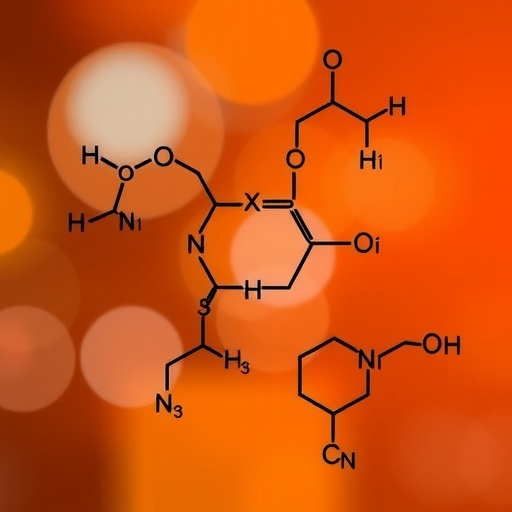Recent advancements in medicinal chemistry have unveiled a fascinating class of compounds known as 1,2,4-oxadiazole derivatives. Researchers led by Zhu Z., Liu X., and Zou Y. have made significant strides in understanding the intricate design and synthesis of 1,2,4-oxadiazole derivatives that incorporate a sulfone moiety. The clinical relevance of these compounds is underscored by their biological activity and potential role in addressing virulence factors associated with various pathogens.
The 1,2,4-oxadiazole ring system is renowned for its diverse pharmacological properties, ranging from anti-inflammatory to antimicrobial activities. This versatility has sparked a keen interest among chemists and biologists alike, leading to a surge in the exploration of novel derivatives that can enhance the efficacy of therapeutic agents. The specific focus on integrating a sulfone functional group is particularly notable, as it is known to influence both the biological activity and solubility of the resultant molecules.
The synthesis of 1,2,4-oxadiazole derivatives typically involves strategic chemical transformations. In their recent study, the researchers utilized a systematic approach that involved careful selection of starting materials and reagents to achieve high yield and purity. By optimizing reaction conditions, they were able to generate a library of sulfone-containing 1,2,4-oxadiazole derivatives. This innovative synthesis not only contributes to the scientific community’s understanding of these compounds but also serves as a foundation for future research endeavors.
Biological testing of the synthesized compounds revealed promising results. The researchers assessed the antibacterial and antifungal activities of these sulfone-modified 1,2,4-oxadiazoles against a range of clinically relevant pathogens. The findings indicate that several derivatives exhibited significant antibacterial activity, suggesting the potential for these compounds to serve as effective antimicrobial agents in the ongoing battle against resistant strains of bacteria. Additionally, preliminary studies hinted at possible antifungal properties, which merit further investigation.
A particularly intriguing aspect of this research lies in the exploration of antivirulence factors. Traditionally, the focus on combating pathogens has centered on killing them or inhibiting their growth. However, the concept of targeting virulence factors offers a unique therapeutic avenue. By disrupting the mechanisms that pathogens use to establish infections—without directly killing them—these compounds could potentially minimize selective pressure, thereby reducing the likelihood of resistance development.
The study’s findings highlight the need for further research into the mechanism of action of these novel derivatives. Understanding how they interfere with pathogen virulence is crucial not only for optimizing their therapeutic potential but also for deciphering the underlying biochemical pathways involved. This knowledge could lead to the identification of biomarkers for susceptibility to treatment, ultimately paving the way for personalized medicine in infectious diseases.
In addition to their antimicrobial potential, the 1,2,4-oxadiazole derivatives displayed intriguing results in cytotoxicity assays. The researchers investigated the selectivity of these compounds towards bacterial cells versus mammalian cells, a critical factor in drug development. The promising selectivity profiles suggest that these derivatives could potentially minimize side effects associated with traditional antimicrobial therapies, thus enhancing patient safety.
As the threat of antimicrobial resistance looms large, the urgency to discover new therapeutic agents is paramount. The ongoing research into 1,2,4-oxadiazole derivatives represents a proactive approach in the field of drug discovery. By harnessing the power of innovative synthetic techniques and phenotypic screening, there is a palpable sense of optimism that these compounds could contribute to a new arsenal in our fight against infectious diseases.
Moreover, the potential application of these sulfone-containing 1,2,4-oxadiazole derivatives extends beyond infectious diseases. Preliminary research suggests that they may exhibit anti-inflammatory properties, further widening their therapeutic scope. Chronic inflammation has been implicated in various diseases, including cancer and autoimmune disorders, underscoring the relevance of these compounds in broader biomedical contexts.
The collaborative efforts of chemists, biologists, and pharmacologists will be key to advancing the understanding of 1,2,4-oxadiazoles in therapeutic settings. As multidisciplinary research fosters innovation, the pathway from the laboratory to clinical application becomes increasingly viable. Future studies focusing on in vivo efficacy and safety profiles will be critical in bringing these promising compounds a step closer to clinical trials.
In conclusion, the investigation of novel 1,2,4-oxadiazole derivatives containing a sulfone moiety stands at the forefront of contemporary medicinal chemistry. The innovative synthesis, coupled with robust biological evaluations, heralds a new chapter in antimicrobial research. The implications of this work extend far beyond the bench, potentially reshaping our approach to infection management and disease treatment.
The future of this research is bright, heralding the possibility of novel therapies that could reshape the landscape of infectious disease treatment. As additional studies unfold, the scientific community is poised to gain deeper insights into the full potential of these intriguing chemical entities.
Furthermore, the integration of advanced molecular modeling techniques could facilitate the design of more targeted derivatives, enhancing the likelihood of successful therapeutic outcomes. This progressive approach emphasizes the importance of rational drug design in the development of next-generation therapeutics.
Research such as this is crucial for addressing urgent public health challenges. With diseases evolving and new pathogens emerging, continued exploration of novel chemical frameworks and their derivatives must remain a priority in the field of drug discovery.
As the narrative of 1,2,4-oxadiazole derivatives unfolds, it is clear that the combination of synthetic ingenuity and biological insight can yield compounds that not only fight pathogens effectively but also pave the way for innovative therapeutic strategies. The journey of these derivatives from conception to potential clinical application will undoubtedly be one that the scientific community will monitor closely in the upcoming years.
Subject of Research: Synthesis and Biological Evaluation of 1,2,4-Oxadiazole Derivatives Containing Sulfone Moiety
Article Title: Novel 1,2,4-oxadiazole derivatives containing a sulfone moiety: Design, synthesis, biological activity, and antivirulence factors.
Article References: Zhu, Z., Liu, X., Zou, Y. et al. Novel 1,2,4-oxadiazole derivatives containing a sulfone moiety: Design, synthesis, biological activity, and antivirulence factors. Mol Divers (2025). https://doi.org/10.1007/s11030-025-11338-9
Image Credits: AI Generated
DOI: 10.1007/s11030-025-11338-9
Keywords: 1,2,4-oxadiazole derivatives, sulfone moiety, biological activity, antivirulence factors, antimicrobial resistance.




